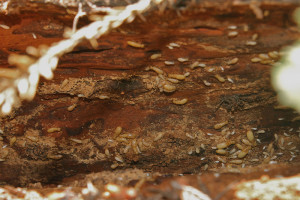Is There Any Type of Wood That is Safe From Termites?
By Chris Williams on June 10, 2014.
Subterranean termites will happily feed on any of the common woods used for structural lumber in homes. It doesn’t matter if it is softwood or hardwood, pine, or oak.
Certain factors make wood even more desirable to termites: high moisture content, softness, the presence of fungus or decay, and the absence of natural chemicals, resins, or oils that make wood resistant to decay and insects. Termites especially like wood that is damp or is rotting.
So it makes sense that the woods that are resistant to termites are the woods that are also naturally resistant to decay or that contain oils that resist moisture. Because they resist decay, you’ll recognize some of these as woods that are used in boats, for outdoor furniture, for decks, and in other situations where the wood is exposed to high moisture levels. The heartwood of these trees has shown some resistant to termites: cypress, cedar, redwood, and teak. Eastern red cedar, also known as juniper, contains natural oils that repel insects, as does sassafras.
There are other exotic woods, which most of us have never heard of, that are naturally resistant to decay and termites: sugi, kamani, milo, kou, and tallowwood. A few woods native to Malaysia have heartwood that is actually toxic to subterranean termites: tualang, casuarinas pine, sentant, and kempas. Needless to say, these woods are not the usual fare offered at Home Depot and most certainly not the woods that have been used in your home.
Are Your Floors Resistant to Termites?
Although hardwood floors are still highly desirable, some homeowners are opting for newer flooring materials, sometimes mistakenly thinking they will be resistant to termite damage.
Bamboo floors
Folks figure bamboo is safe from termites since it is not a wood, technically it’s a grass. But it was a living material and contains starch and sugars which means bamboo is vulnerable to termite attack…if other conditions are right.
Cork floors
Cork is a sustainable resource that is harvested from the bark of the cork tree and can be repeatedly harvested from the same tree. Cork is waxy and repels water so it is less desirable to termites in its installed state. But if cork is consistently damp, it becomes attractive to termites.
Bottom line? For termites, if it’s wood they will eat it…or at least try to. Unless your home is framed in tualang, you need to take precautions which include keeping your wood dry, making sure you have a current termite treatment or baiting system in place, and having regular termite inspections.
Photo credit: edward_rooks / Foter / Creative Commons Attribution-ShareAlike 2.0 Generic (CC BY-SA 2.0)
